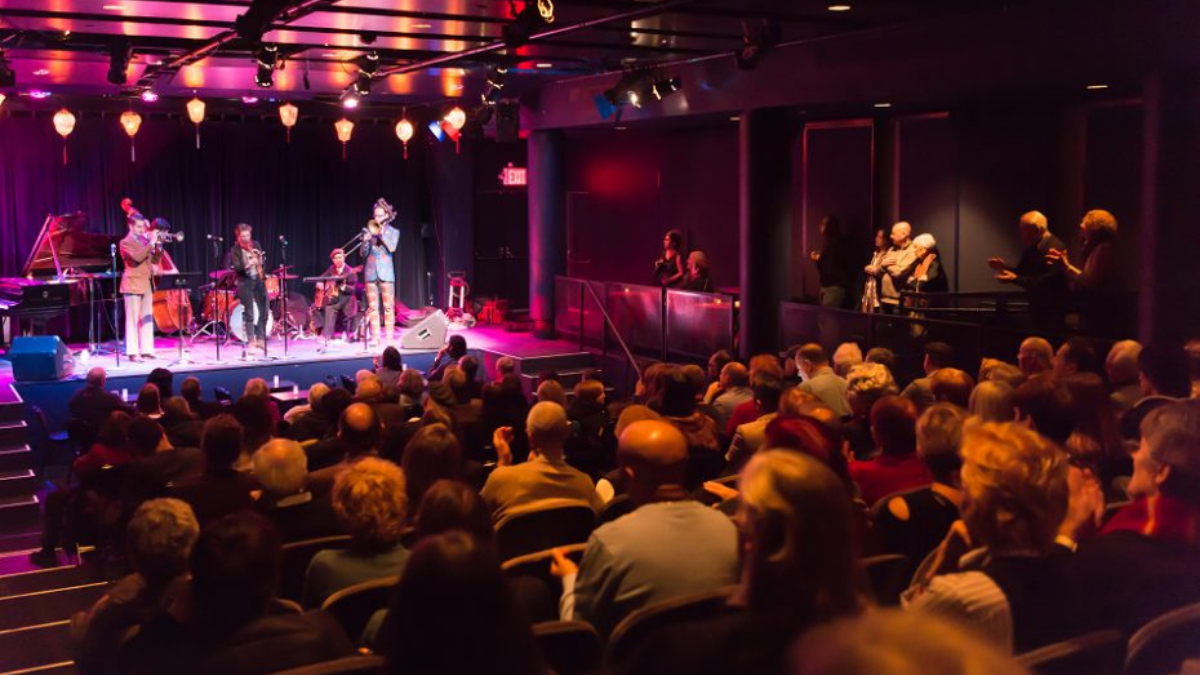This week in Star Trek history: Leonard Nimoy's Thalia Theatre opened on April 8th, 2000

The interior of Leonard Nimoy's Thalia Theatre Image: Symphony Space
APRIL 5, 2022 - Sitting on the southwest corner of 95th St. and Broadway, Symphony Space has been a New York City staple since the 1930s. The venue has housed movies, concerts, live readings, and productions of various types for decades, and in the year 2000, when financial troubles made it look like the end for the performing arts space, Leonard Nimoy helped to keep it afloat.
Beginning in 1915, the site was owned by Vincent Astor, who developed it into Astor Market, a two-story building housing fruit, meat, fish, produce and flower stands. The market failed in only two years, and in 1917 Thomas Healy bought the space and converted it into the Crystal Palace skating rink, with the Sunken Gardens restaurant in the sunken basement.
By the 1930s, the skating rink and restaurant had been turned into a pair of movie houses, the Symphony Theater and, in the basement, the Thalia Theater, the name referring to the Greek Muse of Comedy. But then, in 1978, things changed. Playwright Isaiah Sheffer (whose voice Stephen Colbert described as “having warm caramel poured into your ear and then having it licked out by a narcotized manatee”) and orchestral director Allan Miller took over the theater for Wall to Wall Bach, a free 12-hour music marathon. The incredible success of the event led them to take out a lease on the building and open the newly-renovated Symphony Space.
Things weren’t exactly smooth sailing for the Symph, as it is affectionately known by some. In order to take over the space, Sheffer and Miller had to make some thorny deals and there was a 30-year legal battle ahead of them, resolving in their favor it 1996. But, as they say, “too little, too late.” The Thalia Theatre had closed in 1987, a victim of the legal issues. The space’s financial troubles weren’t over, however, and by the end of the 20th century, it looked like the home of Selected Shorts and the annual Bloomsday on Broadway celebration would be closing.
But Sheffer was a stubborn son-of-a-gun, and he went out in search of an endowment to keep the theater alive. He sold the air rights above the building for $10 million and accepted donations from a number of sources, including Leonard and Susan Bay Nimoy.
Nimoy and Sheffer had been friends for decades. Both Jewish men who loved Yiddish theater, they had a lot in common and visited each other whenever they had the chance. When Sheffer needed support to save Symphony Space, Nimoy and his wife stepped in without hesitation.
The theater underwent a 2-year renovation, which included integrating the long-defunct Thalia Theatre back into the basement of the building and renaming it “Leonard Nimoy’s Thalia Theatre.” Symphony Space and the Thalia are still thriving today.
I had the opportunity to Stage Manage a number of performances in the Thalia about 15 years ago. I was set up in the center of the dimly-lit control booth on a chair with a music stand for my script. In front of me were large windows looking out onto the audience and the stage, with the lighting and sound operators sitting in front of me, taking the cues I was calling out. To my left was the projector and its operator, and I was struck by the fact that, whether by accident or design, the setup was reminiscent of the bridge of the Enterprise. The lighting and sound operators were in Sulu and Chekov’s positions, the projectionist was positioned by Spock’s science station, and I was privileged to be in the Center Seat.
Isaiah retired a few years before Mr. Nimoy was diagnosed with COPD. Symphony Space held a star-studded tribute for him, directed by James Naughton (Planet of the Apes, the TV series), Broadway’s Brian Stokes Mitchell, Stephen Colbert, and Fritz Weaver (Star Trek: Deep Space Nine’s “Tribunal”), among others. Leonard Nimoy also appeared to give a tribute. He was a quiet, gentle man. Very polite, very dignified. On this occasion, I was stationed backstage, calling the show, when I felt a presence beside me. I glanced over to see Mr. Nimoy in a very Spockian pose, back straight, hands clasped behind his back, quietly watching the performances and listening to me give cues. It’s a moment I will always treasure.
Isaiah and Mr. Nimoy have both left us now, but their legacies live on. Symphony Space continues to perform Selected Shorts and celebrate Bloomsday and the Leonard Nimoy Thalia Theatre is still going strong, with visiting presenters, concerts, and other types of productions regularly taking place. It’s possible, maybe even likely, that without Mr. Nimoy’s involvement, Symphony Space would not still exist and the Thalia Theatre would be nothing more than a distant memory. New York City’s lovers of performance art owe a debt to Isaiah Sheffer’s vision and Leonard Nimoy’s support of that vision.
If you want more information about Symphony Space or Leonard Nimoy’s Thalia Theatre, or want to purchase tickets to an event, visit the Symphony Space website.
Further Reading
T is the Managing Editor for Daily Star Trek News and a contributing writer for Sherlock Holmes Magazine and a Shakespeare nerd. He may have been the last professional Stage Manager to work with Leonard Nimoy, has worked Off-Broadway and regionally, and is the union Stage Manager for Legacy Theatre, where he is currently working with Julie Andrews. after which he’ll be working on Richard III at Elm Shakespeare Company.





